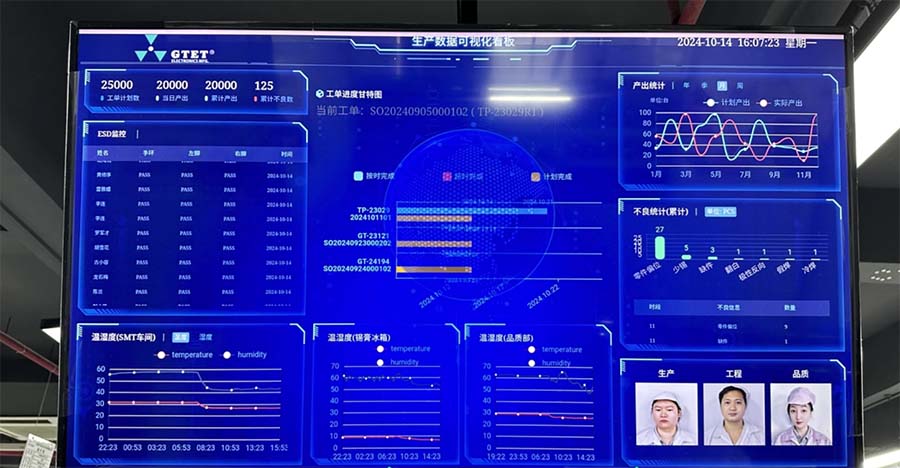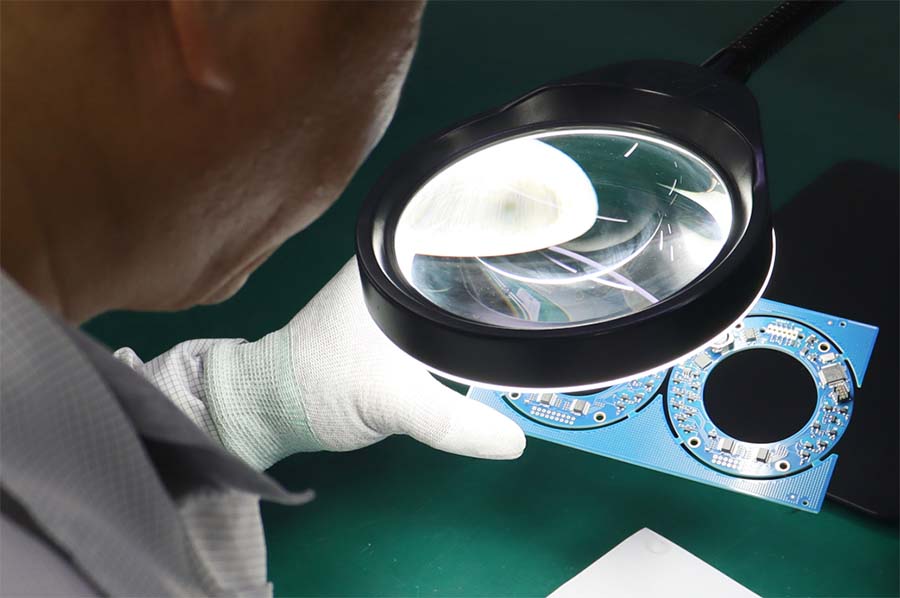Introduction | Why Industrial Control Boards Require a “Digital Identity”
Industrial control boards differ from consumer electronics—they operate year-round in harsh environments characterized by high temperatures, humidity, vibration, and electromagnetic interference, performing critical functions in production lines, power systems, and traffic control. When failures occur, the cost of downtime often far exceeds the value of the board itself. Thus, “usability” is merely the baseline, while “manageability” represents the industrial standard: each control board requires a comprehensive “digital identity” that records full lifecycle data from raw materials to finished products, and from factory to field, enabling rapid fault localization, predictive maintenance, and recall management.
This article examines the unique aspects of industrial control boards, analyzes key points for implementing traceability and MES systems, and, based on TORTAI Technologies‘ existing capabilities, presents practical solutions spanning barcode management, data acquisition, and cloud storage.
1、The “Digital Manufacturing” Trend and Pain Points for Industrial Control Boards
Industry Background: Smart Manufacturing Transformation Driven by Industry 4.0
Device Connectivity and Data Acquisition: Industrial IoT requires control boards to have network connectivity and data reporting capabilities, with fault and performance data traceable to specific batches and components.
Predictive Maintenance: Transitioning from “fixing after failure” to “early warning” requires historical data to support lifespan prediction and replacement recommendations.
Compliance and Auditing: Functional safety standards (e.g., IEC61508), environmental regulations (RoHS/REACH), and quality system audits all demand complete manufacturing records and material traceability.
Rapid Localization and Recall: During field failures, the ability to quickly trace specific batches, suppliers, and process parameters reduces impact scope and handling costs.
Current Pain Points: Limitations of Traditional Manufacturing Models
Data Silos: Design, procurement, manufacturing, and testing stages use disparate systems, making data integration challenging; fault analysis requires extensive manual searching and verification.
Traceability Gaps: Critical information (e.g., component batches, process parameters, test data) is recorded in paper reports or local files, prone to loss and difficult to retrieve quickly.
Reactive Responses: Lack of real-time data and trend analysis means issues are often detected only after batch failures, resulting in high handling costs.
Version Confusion: Unmanaged BOM changes, firmware updates, and process adjustments lead to mismatches between field devices and production records.

2、 The “Three-Tier Architecture” of Traceability: Data, Process, and System
(1) Data Identification and Acquisition
Unique Identification: Each control board is assigned a unique SN (serial number), linked to basic information such as PCB batch, assembly date, test station, and operator.
Key Node Data Acquisition
Incoming Inspection: Component batch, supplier, receipt date, sampling results
SMT/THT Processes: Solder paste batch, reflow temperature profile, first-article test results
In-Line Inspection: SPI, AOI, X-Ray inspection images and judgment results
Functional Testing: ICT/FCT test data, calibration parameters, performance curves
Packaging and Shipping: Final testing, burn-in time, packaging date, shipment batch
(2)Process Standardization and Exception Handling
Process Solidification: Embed standard operating procedures (SOP) and data collection points into MES workflows to ensure critical steps are not omitted.
Automatic Exception Tagging: Automatically record anomalies such as test parameter exceedances, rework, and material changes, forming quality event archives.
Version Management: Associate BOM changes, firmware updates, and process adjustments with production batches to ensure each board corresponds to the accurate technical state.
(3) System Integration and Data Application
ERP Integration: Connect material, order, and delivery information with MES data to support supply chain coordination and delivery management.
Cloud Storage: Back up critical data to the cloud for remote access, long-term preservation, and big data analysis.
Mobile Applications: Field engineers quickly retrieve historical data, fault records, and maintenance recommendations by scanning SNs.
3、Key Roles of MES Systems in Industrial Control Board Manufacturing
Production Execution Level: From “Manual Recording” to “Automatic Acquisition”
Work Order Management: Automatically generate production orders based on customer orders, guiding material distribution, process routes, and quality standards.
Real-Time Monitoring: Visualize real-time status of workstations, WIP locations, and equipment operating parameters, with timely alerts for anomalies.
Data Acquisition: Integrate with SMT equipment, test equipment, and inspection devices to automatically collect key process parameters and test results.
Quality Control Level: From “Sampling Inspection” to “Full Process Monitoring”
SPC Statistical Process Control: Real-time statistics and trend analysis of key parameters to promptly detect process deviations.
First-Article Verification: Automatically compare first-article test data against standard ranges; batch production proceeds only after approval.
Error and Mix-Up Prevention: Barcode scanning and system verification prevent material misuse, process step skipping, and product batch mixing.
Traceability Analysis Level: From “Post-Incident Searching” to “Second-Level Localization”
Forward Traceability: Trace from raw material batches to final products, supporting impact assessment of supplier quality issues.
Reverse Traceability: Trace from field-failed products back to specific components, process parameters, and test data for rapid root cause identification.
Batch Analysis: Compare quality performance of same-batch products to identify systemic issues and improvement opportunities.

4、Technical Implementation Essentials: Full-Stack Solutions from Hardware to Software
Hardware Foundation: Barcodes, RFID, and Data Acquisition Devices
Barcode Systems: 1D/2D barcode printing, scanning, and verification to ensure clear, unique, and durable identification.
RFID Tags: Provide higher reliability and efficiency in harsh environments or scenarios requiring batch reading.
Data Acquisition Terminals: Industrial-grade scanners and handheld terminals for stable operation in demanding conditions.
Software Architecture: Modular, Scalable, and Easily Integrable
MES Core Modules: Work order management, process routing, quality control, equipment integration, and report analysis
Database Design: Relational databases for structured data; time-series databases for equipment operating parameters
Interface Standards: Support industrial communication protocols such as OPC-UA, Modbus, and MQTT for easy integration with various devices
Cloud Services: Data backup, remote access, mobile applications, and big data analysis
Data Security: Information Security Assurance in Industrial Environments
Network Isolation: Physically separate production and office networks to prevent external attacks.
Access Control: Role-based access control ensures sensitive data is visible only to authorized personnel.
Data Backup: Dual backup locally and in the cloud supports disaster recovery and long-term preservation.
5、What We Offer: MES and Traceability Solutions Based on TORTAI Technologies’ Existing Capabilities
PCBA/EMS Manufacturing Capabilities and Traceability Integration
High-Speed SMT/THT Lines: Equipped with SPI, AOI, X-Ray, and other in-line inspection devices, integrated with MES for automatic data acquisition.
ICT/FCT Testing: Automatic upload of functional test data to MES, stored in association with SNs, supporting historical comparison and analysis of test curves.
Conformal Coating and Post-Processes: Synchronize coating parameters and UV laser marking content with MES to ensure traceability of each process.
MES Systems and Barcode Management
Next-Generation MES Platform: Integrated work order management, real-time monitoring, quality control, and equipment integration, supporting complex process flows for industrial control boards.
End-to-End Barcode Management: Full-process barcode identification from incoming materials to finished products, preventing errors and mix-ups, and supporting forward/reverse traceability.
Cloud Data Storage: Cloud backup of critical data enables remote access and long-term preservation, meeting audit and compliance requirements.
Quality Control and Exception Management
SPC Statistical Analysis: Real-time statistics and control charts for key parameters to promptly identify process anomalies.
First-Article Verification System: Automatic validation of first-article test data; production halts automatically if standards are not met, avoiding batch risks.
Exception Event Management: Automatic recording of rework, material changes, test failures, and other anomalies, forming a complete quality event chain.
Mobile Applications and Field Support
Mobile APP: Scan SNs to quickly retrieve product information, test data, and quality records, enabling rapid on-site diagnosis.
Remote Technical Support: Remote fault analysis and solution recommendations based on traceability data.
Note: We focus on MES and traceability capabilities on the manufacturing side. Certification standards such as functional safety and EMC are the responsibility of customers and third-party agencies; we provide manufacturing data support and cooperation.
6、Application Scenarios and Case Studies
Case 1: Predictive Maintenance for Power System Control Boards
Background: A power equipment manufacturer required control boards to operate continuously for over 10 years in harsh outdoor environments.
Solution: Established a comprehensive MES traceability system recording component batches, test data, and environmental stress information for each board.
Result: Historical data analysis identified failure-prone components and batches in advance, guiding predictive replacement strategies and increasing equipment availability by 15%.
Case 2: Rapid Fault Localization for Industrial Automation Control Boards
Background: An automation equipment manufacturer struggled with rapid problem localization during field failures.
Solution: Deployed a mobile traceability application allowing field engineers to access complete manufacturing and test histories by scanning SNs.
Result: Average fault localization time reduced from 4 hours to 30 minutes, significantly improving customer satisfaction.
Case 3: Recall Management for Automotive Electronic Control Boards
Background: An automotive electronics supplier needed to quickly determine the impact scope of specific component batches.
Solution: Utilized MES traceability data to rapidly identify affected product batches and customers.
Result: Precise control of recall scope avoided massive costs associated with full recalls, earning customer recognition.
7、Implementation Pathway: Phased Progression to Mitigate Risks
Phase 1: Basic Data Acquisition (1-2 months)
Establish a barcode identification system and enhance data acquisition at key nodes.
Deploy MES core modules for work order management and production monitoring.
Train operators to ensure accuracy and completeness of data acquisition.
Phase 2: System Integration Optimization (2-3 months)
Deep integration with test and inspection equipment for automatic data acquisition.
Enhance traceability functions to support forward/reverse tracing and batch analysis.
Develop mobile applications for rapid on-site querying and diagnosis.
Phase 3: Data Application Enhancement (Continuous Optimization)
SPC analysis and early warning based on historical data.
Establish and optimize predictive maintenance strategies.
Interface with customer systems for supply chain collaboration.
8、Conclusion and Outlook
Traceability of industrial control boards and MES implementation is not only a technical requirement of digital manufacturing but also an essential path for transitioning from “manufacturing” to “smart manufacturing.” By establishing a comprehensive digital identity system, we can transform each control board from a “silent hardware component” into a “smart terminal that communicates,” creating comprehensive value for customers through rapid fault localization, predictive maintenance, and supply chain optimization.
TORTAI Technologies is committed to collaborating with partners to drive the digital upgrade of industrial control board manufacturing based on existing MES and traceability capabilities, making “manageability” the new standard for industrial reliability.


